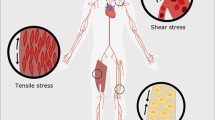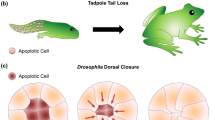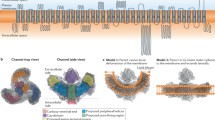Abstract
It has been a long time since the term mechanobiology became widely accepted, and broad research approaches, ranging from basic biology to medical research, have been conducted from the perspective of mechanobiology. Our group created the term “mechanomedicine” focusing on the field encompassing studies of the pathology and treatment of various diseases based on the knowledge obtained from mechanobiological studies and have promoted studies in this field. In the respiratory and cardiovascular systems, not only humoral factors but also physical factors such as contraction and expansion phenomena, and feedback from such phenomena to tissues and cells are important stimuli for maintaining homeostasis. Loss of homeostasis is considered to lead to pathological conditions. This review aims to provide an overview of mechanomedicine by introducing several mechanosensitive channels including one particular type of mechanosensor that we discovered in the cardiovascular system and by describing stretchable three-dimensional cell culture scaffolds using self-assembled peptides, a highly motile sperm sorter using a sperm sorting technique based on microfluidic mechanics, and a device to promote the development of fertilized ova.
Similar content being viewed by others
Avoid common mistakes on your manuscript.
What is mechanomedicine?
Our group created the term “mechanomedicine” focusing on the field encompassing studies of the pathology and treatment of various diseases based on the knowledge obtained from mechanobiological studies and have promoted studies in this field (Naruse 2013, 2017a, b, 2018). Previous studies have widely investigated responses to mechanical stimuli exerted on tissues and cells, such as stretch, shear stress, and hydrostatic pressure. These include the mechanisms that convert mechanical stimuli to electrical signals in the sensory systems. Examples such as touch and hearing and the response of a bronchus or the myocardium to mechanical stimuli have been evaluated at the intracellular and tissue levels. Other commonly studied topics at the cellular level include phenomena associated with cell movement and chemotaxis in the cytoskeleton and focal adhesions. At the single molecule level, structural changes caused by applying stress to protein and changes in the molecular function of stretch-activated channels, enzyme activity, have also been reported. As described above, mechanobiological studies have been steadily progressing. The concept of mechanomedicine is derived from mechanobiology and was developed to encompass pathological understanding and treatment of diseases. Our group has conducted studies on the pathology and treatment of not only cardiovascular and respiratory diseases but also motor system and reproductive diseases. These studies are important for both conventional medicine and regenerative medicine.
Mechanosensors
Although many molecular aspects of mechanosensors most upstream of mechanotransduction remain unknown, only mechanosensitive channels are well-understood. Numerous studies have directly measured single ionic currents activated by stretching the plasma membrane using the patch-clamp technique. The subjects in typical studies, including those involving our group, include a nonselective cation channel Mid1 (yeast) (Kanzaki et al. 1999), intracellular calcium-dependent stretch-activated potassium channel (SAKCA; myocardium, described later) (Kawakubo et al. 1999; Naruse et al. 2009), and transient receptor potential vanilloid isoform 2 (TRPV2; endothelial cell and myocardium, described later) (Katanosaka et al. 2007; Katanosaka et al. 2014). Other groups have reported a large-conductance mechanosensitive ion channel (MscL, Escherichia coli) (Martinac et al. 1987, 1990), Piezo type (Coste et al. 2012), etc. Additionally, it has been suggested that focal adhesion proteins are mechanosensors (Wang et al. 1993).
Cardiovascular system
Endothelial cells
Blood vessels are constantly exposed to mechanical stimuli, such as shear stress from blood flow, hydrostatic blood pressure, and pulsatile stretch due to systolic-diastolic fluctuations. In response to these stimuli, endothelial and smooth muscle cells secrete vasoactive substances to maintain tonus, express genes and proteins, and cause morphological changes. Disruption of these mechanisms may cause various diseases, such as hypertension and arteriosclerosis. We developed and marketed devices that apply a stretching stimulus to cultured cells (Fig. 1a). The stretch chamber consists of a cell culture unit composed of extendable transparent silicone resin (polydimethylsiloxane, PDMS). It has a membrane approximately 100 μm thick, coated with an extracellular matrix protein, such as fibronectin. Endothelial cells are cultured in the chamber (Fig. 1b). Using a microscope-compatible stretching device (Fig. 1c), a 20% stretch stimulus is applied for 3 s. As a result, the intensity-dependent intracellular Ca2+ level transiently increases and the mechanosensitive channel is blocked with Gd3+ (Fig. 1d).
It is suggested that TRPV2 channels in endothelial cells function as a mechanosensor to transport Ca2+ in a stretch-dependent manner. Stretching human embryo kidney (HEK) cells only minimally increased stretch-dependent Ca2+ levels, whereas stretching TRPV2-expressing HEK cells increased Ca2+ levels to a greater extent. Moreover, in human umbilical vein endothelial cells (HUVECs), increases in stretch-dependent Ca2+ levels disappear by including a small interfering ribonucleic acid (siRNA) targeting TRPV2 channel (Katanosaka et al. 2007).
Various studies have also evaluated intracellular signal transduction in endothelial cells stimulated by stretching (mechanotransduction). Endothelial cells are aligned perpendicular to the direction of the stretch (Naruse and Sokabe 1993). During this process, protein tyrosine phosphorylation of focal adhesion kinase (FAK) is introduced, which is dependent on increases in intracellular Ca2+ levels. When phosphorylation of FAK was inhibited or blocked, stretch-dependent alignment was also inhibited. Thus, FAK itself was shown to be important for this alignment (Yamada et al. 2000). Furthermore, stretching stimulation increases intracellular levels of cyclic adenosine monophosphate (cAMP) (Yamada et al. 2000) and causes the production of superoxide (Aikawa et al. 2001) and nitric oxide (NO) (Takeda et al. 2006), as well as activating nuclear factor kappa B (NFκB) (Kobayashi et al. 2003).
Myocardium
The heart is a dynamic organ that repeatedly contracts and relaxes. This activity is induced by electrical excitation, a mechanical-electrical-feedback mechanism also controls the electrical features of contraction and expansion (Kohl and Sachs 2001). The myocardia also contain various mechanosensitive channels (Bustamante et al. 1991). Depending on contraction and expansion, the myocardia are activated and the resulting ionic changes alter the states of contraction and expansion. Our group established a model of stretch-dependent arrhythmia induced by Iribe et al. (2011) using a carbon fiber electrodes and isolated cardiomyocytes (Fig. 2a) to measure tension and electrophysiological activity (Fig. 2b) (Iribe et al. 2013). Additionally, we recently developed a new stretching method that allows expansion of the myocardia up to the physiological sarcomere length experienced in the heart (Fig. 2c) (Iribe et al. 2014).
a Intraventricular balloon expansion using Langendorff-perfused samples. b Method using carbon fiber electrodes and isolated cardiomyocytes to measure myocardial tension and electrophysiological experiments. c A new stretching method that allows expansion of the myocardium up to physiological sarcomere length
Mechanosensitive channels
SAKCA (stretch-activated Ca2+-activated K+ channel) is a K+-permeable mechanosensitive channel present in the cultured chick ventricular cardiac muscle. Interestingly, it is activated by intracellular Ca2+ and ATP (Kawakubo et al. 1999). Thus, we cloned the channel using degenerate primers against BKCa channel from the chick embryonic heart cDNA library and found out that the channel contains the STREX (stress-axis regulated exon) sequence. This sequence is important for stretch activation (Fig. 3a) (Naruse et al. 2009). In the heart, TRPV2 channels exist in the intercalated disks. During systole, these disks are stretched in the direction of the force. We generated TRPV2 conditional knockout mice to analyze their phenotypes (Fig. 3b) (Katanosaka et al. 2014). Nine days after administration of tamoxifen to induce Cre recombinase, nearly all TRPV2 disappeared from the intercalated disks which simultaneously collapsed, causing ventricular dilatation. Cardiac pump function was also reduced and nearly all mice died 1 week later. When isolated newborn myocardial cells were cultured, stretch stimulation did not increase intracellular Ca2+ levels. Additionally, cell morphology was abnormal. Interestingly, these mice were rescued by administering insulin-like growth factor 1 (IGF-1). This suggests that increases in intracellular Ca2+ levels following activation of TRPV2 is associated with the phosphatidylinositol 3-kinase (PI3K)/protein kinase B (AKT) pathway.
Other studies in mechanomedicine
To apply stretching and relaxing stimuli to motor organs (e.g., skeletal muscles), as well as cartilage, and bone, stretchable three-dimensional cell culture scaffold was developed that was fully synthesized, self-assembled peptide that substituted for animal-derived collagen (Nagai et al. 2012). Importantly, this peptide acts as a hemostatic drug (Fig. 4a) (Komatsu et al. 2014). Also, we developed a highly motile sperm sorter using a technique based on microfluidic mechanics (Fig. 4b) (Matsuura et al. 2012. This device promotes the development of fertilized ova by applying shear stress generated in the Fallopian tubes where the ova are fertilized (tilting embryo culture system, TECS) (Fig. 4c) (Matsuura et al. 2010). These devices are currently being used in clinical practice (Hara et al. 2013).
a A molecular model of self-assembling peptide SPG-178 and a diagram of the formation of the hydrogel from the peptide monomer. b The Microfluidic motile sperm sorter Qualis® is composed of four numbered chambers ①, ②, ③, ④, and a micro channel connected to each chamber. After applying sperm sorting medium to chambers ②, ③, ④ and a semen sample to chamber ① in an appropriate amount, two streams of fluid with laminar flow can be formed in parallel (① → ④, ② → ③). Only motile spermatozoa are allowed to swim into the parallel stream, followed by being isolated from chamber ③. c Tilting embryo culture system. This device consists of a control unit and a motor unit with a tilting plate with four-well chambers. Mouse embryos were cultured at a tilt angle of 20° with a holding time of 1 min. It was then rotated at a tilt angle of − 20° with a holding time of 1 min, and the cycle was repeated
The above mechanomedicine techniques have been used in studies of the cardiovascular and other systems, and they have achieved favorable results. The information presented in this review could prove valuable to researchers in these fields.
Conclusion
In Japan, mechanobiological studies have been promoted through grants, such as the Grant-in-Aid for Specially Promoted Research in the Grants-in-Aid for Scientific Research and the International Cooperative Research Project (ICORP) of the Japan Science and Technology Agency. During 2010–2012, mechanobiology was included in the list of disciplines and research fields with a time limit. Thus, mechanobiology became a new science and field of technology in Japan. Mechanobiology integrates physics, engineering, medicine, and biology, making active collaboration with researchers from different fields essential.
We hope that the active involvement of many researchers and clinicians in this mechano field will lead to the reconsideration of studies, diagnoses, and treatment of various diseases.
References
Aikawa K, Nishikimi N, Sakurai T, Nimura Y, Sokabe M, Naruse K (2001) SA channel mediates superoxide production in HUVECs. Life Sci 69:1717–1724
Bustamante JO, Ruknudin A, Sachs F (1991) Stretch-activated channels in heart cells: relevance to cardiac hypertrophy. J Cardiovasc Pharmacol 17(Suppl 2):S110–S113
Coste B, Xiao B, Santos JS, Syeda R, Grandl J, Spencer KS, Kim SE, Schmidt M, Mathur J, Dubin AE, Montal M, Patapoutian A (2012) Piezo proteins are pore-forming subunits of mechanically activated channels. Nature 483:176–181. https://doi.org/10.1038/nature10812
Hara T, Matsuura K, Kodama T, Sato K, Kikkawa Y, Muneto T, Tanaka J, Naruse K (2013) A tilting embryo culture system increases the number of high-grade human blastocysts with high implantation competence. Reprod BioMed Online 26:260–268. https://doi.org/10.1016/j.rbmo.2012.11.014
Iribe G, Jin H, Naruse K (2011) Role of sarcolemmal BK(Ca) channels in stretch-induced extrasystoles in isolated chick hearts. Circ J 75:2552–2558
Iribe G, Kaihara K, Ito H, Naruse K (2013) Effect of azelnidipine and amlodipine on single cell mechanics in mouse cardiomyocytes. Eur J Pharmacol 715:142–146. https://doi.org/10.1016/j.ejphar.2013.05.030
Iribe G, Kaneko T, Yamaguchi Y, Naruse K (2014) Load dependency in force-length relations in isolated single cardiomyocytes. Prog Biophys Mol Biol 115:103–114. https://doi.org/10.1016/j.pbiomolbio.2014.06.005
Kanzaki M, Nagasawa M, Kojima I, Sato C, Naruse K, Sokabe M, Iida H (1999) Molecular identification of a eukaryotic, stretch-activated nonselective cation channel. Science 285:882–886
Katanosaka Y, Iwasaki K, Ujihara Y, Takatsu S, Nishitsuji K, Kanagawa M, Sudo A, Toda T, Katanosaka K, Mohri S, Naruse K (2014) TRPV2 is critical for the maintenance of cardiac structure and function in mice. Nat Commun 5(3932). https://doi.org/10.1038/ncomms4932
Katanosaka Y, Suemori T, Naruse K (2007) The role of TRP channels in mechanotransduction of HUVEC. Biophys J 92:291A
Kawakubo T, Naruse K, Matsubara T, Hotta N, Sokabe M (1999) Characterization of a newly found stretch-activated KCa, ATP channel in cultured chick ventricular myocytes. Am J Phys 276:H1827–H1838
Kobayashi S, Nagino M, Komatsu S, Naruse K, Nimura Y, Nakanishi M, Sokabe M (2003) Stretch-induced IL-6 secretion from endothelial cells requires NF-kappaB activation. Biochem Biophys Res Commun 308:306–312
Kohl P, Sachs F (2001) Mechano-electric feedback in cardiac cells. Philos Trans R Soc A 359:1173–1185
Komatsu S, Nagai Y, Naruse K, Kimata Y (2014) The neutral self-assembling peptide hydrogel SPG-178 as a topical hemostatic agent. PLoS One 9:e102778. https://doi.org/10.1371/journal.pone.0102778
Martinac B, Adler J, Kung C (1990) Mechanosensitive ion channels of E. coli activated by amphipaths. Nature 348:261–263
Martinac B, Buechner M, Delcour AH, Adler J, Kung C (1987) Pressure-sensitive ion channel in Escherichia coli. Proc Natl Acad Sci U S A 84:2297–2301
Matsuura K, Hayashi N, Kuroda Y, Takiue C, Hirata R, Takenami M, Aoi Y, Yoshioka N, Habara T, Mukaida T, Naruse K (2010) Improved development of mouse and human embryos using a tilting embryo culture system. Reprod BioMed Online 20:358–364. https://doi.org/10.1016/j.rbmo.2009.12.002
Matsuura K, Takenami M, Kuroda Y, Hyakutake T, Yanase S, Naruse K (2012) Screening of sperm velocity by fluid mechanical characteristics of a cyclo-olefin polymer microfluidic sperm-sorting device. Reprod BioMed Online 24:109–115. https://doi.org/10.1016/j.rbmo.2011.09.005
Nagai Y, Yokoi H, Kaihara K, Naruse K (2012) The mechanical stimulation of cells in 3D culture within a self-assembling peptide hydrogel. Biomaterials 33:1044–1051. https://doi.org/10.1016/j.biomaterials.2011.10.049
Naruse K, Sokabe M (1993) Involvement of stretch-activated ion channels in Ca2+ mobilization to mechanical stretch in endothelial cells. Am J Phys 264:C1037–C1044
Naruse K, Tang QY, Sokabe M (2009) Stress-axis regulated exon (STREX) in the C terminus of BK(Ca) channels is responsible for the stretch sensitivity. Biochem Biophys Res Commun 385:634–639. https://doi.org/10.1016/j.bbrc.2009.05.105
Naruse K (2013) Mechanomedicine: applications of mechanobiology to regenerative and reproductive medicine. Keynote lecture in the 7th International Conference on Microtechnologies in Medicine and Biology (MMB 2013) on April 10-12, 2013 in Marina del Rey, California, USA
Naruse K (2017a) Mechanomedicine: mechanobiology and its implications for the field of regenerative rehabilitation. Plenary lecture in the 6th Annual International Symposium on Regenerative Rehabilitation on November 1-3, in Wyndham Grand Pittsburgh Downtown, Pittsburgh, USA
Naruse K (2017b) Mechanomedicine. Plenary lecture in the annual meeting of the Australian Society for Biophysics on November 28, in University of Technology Sydney, Sydney, Australia
Naruse K (2018) Mechanomedicine: applications of mechanobiology to medical sciences and next-generation medical technologies. J Smooth Muscle Res 54:83–90
Takeda H, Komori K, Nishikimi N, Nimura Y, Sokabe M, Naruse K (2006) Bi-phasic activation of eNOS in response to uni-axial cyclic stretch is mediated by differential mechanisms in BAECs. Life Sci 79:233–239
Wang N, Butler JP, Ingber DE (1993) Mechanotransduction across the cell surface and through the cytoskeleton. Science 260:1124–1127
Yamada T, Naruse K, Sokabe M (2000) Stretch-induced morphological changes of human endothelial cells depend on the intracellular level of Ca2+ rather than of cAMP. Life Sci 67:2605–2613
Acknowledgments
This work was supported by Grants-in-aid for Scientific Research (S) (26220203) and by a Grant-in-Aid for Exploratory Research (17K20108) from the Ministry of Education, Science, Sports and Culture of Japan.
Author information
Authors and Affiliations
Corresponding author
Ethics declarations
Conflicts of interest
The author is a research adviser of Menicon Co. Ltd., a founder of STREX, and obtains grants and consultant fees from MENICON Life Science.
Ethical approval
This article does not contain any studies with human participants or animals performed by the author.
Rights and permissions
Open Access This article is distributed under the terms of the Creative Commons Attribution 4.0 International License (http://creativecommons.org/licenses/by/4.0/), which permits unrestricted use, distribution, and reproduction in any medium, provided you give appropriate credit to the original author(s) and the source, provide a link to the Creative Commons license, and indicate if changes were made.
About this article
Cite this article
Naruse, K. Mechanomedicine. Biophys Rev 10, 1257–1262 (2018). https://doi.org/10.1007/s12551-018-0459-7
Received:
Accepted:
Published:
Issue Date:
DOI: https://doi.org/10.1007/s12551-018-0459-7








